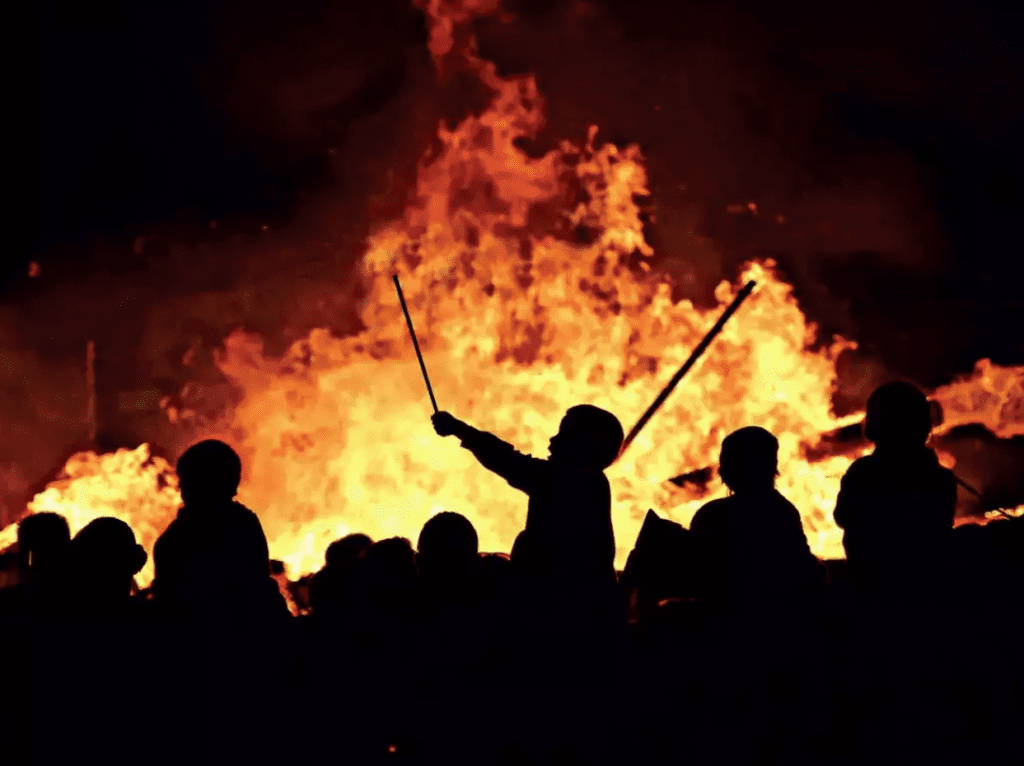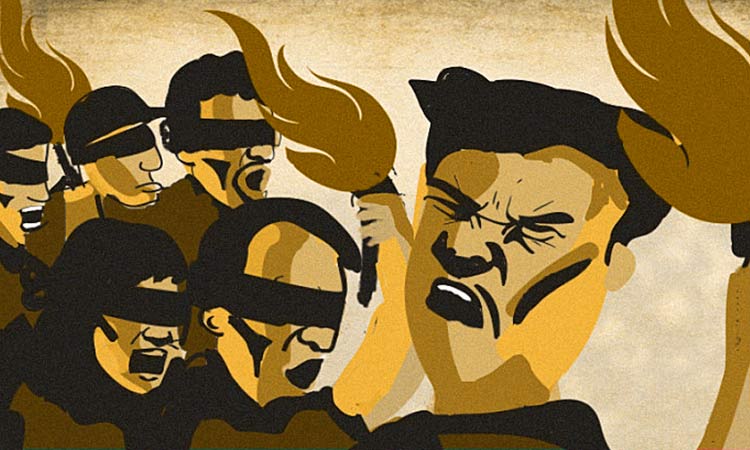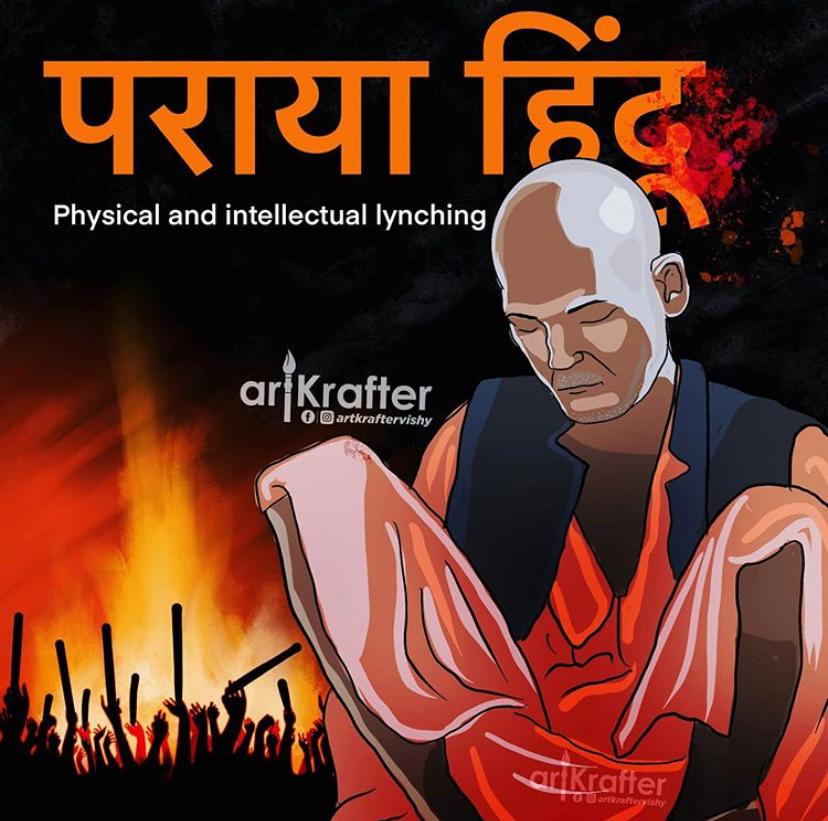
The crowd has no face. As true as this statement is, the actions taken by the crowd are channeled in a certain direction. No face is needed to identify the thoughts supporting these actions and whether or not they lie within judicial parameters. This crowd has snatched away the sword of judgment and now wields it over the necks of not only their culprits but also that of the very system that we, as humans, spent centuries creating to avoid the chaos we had lived within for so long. A choice that we must all make lies ahead of us; a choice from everyone and a choice for everyone.
The uproar of a negatively charged crowd leads to some very fearful and criminal offenses such as mob lynching. Mob lynching is a crime that has recently stepped into the light. A threat of tearing down the very fabric of the Indian society has come up due to the rising incidents of mob lynching and negligence towards vigilantism. Due to the lack of central legislation specifically regarding mob lynching, these incidents are ignored and the poisons of hatred and violence that they brew remain unacknowledged. This article aims to cover various aspects regarding mob lynching.
As per the Oxford English dictionary, ‘lynching’ is the act of killing(s) committed by a mob without the engagement of any legal authority or procedure. Mob lynching, however, has now taken the form of an independent and illegal body which acts its own judge, jury, and executioner and punishes the culprits using physical violence which, almost certainly, leads to death. Hence, it can be considered as extrajudicial public executions performed by a mob in order to punish a transgressor.
Lynching is performed on the basis of two common reasons. Lack of trust in the efficiency of the judicial system is one of these reasons. People who believe that the judicial system is not functioning the way it should or those who are dissatisfied with a specific or a general decision was taken by the judicial system come together and aim at achieving a certain goal decided on the basis of common interest. This results in an uprising against the system in the disguise of a righteous rebellion. The people think it is their duty to punish the said culprit and hence, they come together and punish the culprit using the measures deemed fit by them.
The second reason is one that leans more towards personal interests and gives rise to discriminatory threats. People who enjoy a majority in a particular region sometimes want members from the minority to follow a lifestyle on similar grounds as those of the majority. And when a person takes a stand against this on the grounds of his/her own right to choose, they are slaughtered, stripped away from everything hope they see in humanity as they lie at the mercy of those who chose to raise weapons when denied the desire to raise armies.
Major reasons behind Mob Lynching
Aside from or in line with these common motives, there are certain specific aspects which trigger mob lynching:
- Lack of Answerability and Conviction
The major advantage that the mob holds is that in a case of lynching resulting in the death of the victim, the entire mob cannot be held responsible for the death according to law. Although the entire mob may be held accountable for the lynching, only a single person will face the charges regarding the death of the victim. Identification of this primary culprit is almost impossible as it depends on determining which blow landed on the victim resulted in his/her death and who amongst the crowd had landed the blow itself. Hence, a sense of safety is developed within the mob as to any extent; the punishment for physical torture is still less than that for homicide.
- Absence of Necessary Legislation and Impunity
We, as citizens, expect a certain amount of fear to dwell within every person from the judicial agencies as to what punishment they might face when they intentionally go against the law. However, in our Constitution, there is no specific law regarding mob lynching. Mob lynching in itself is not a cognizable offense but the various actions taken under it come out as punishable under laws acknowledging a wider range of criminal activity such as physical harassment and homicide. Due to a lack of specific laws, the culprits don’t fear the system, especially when there is no way of identifying individuals culpable for the offense.

- Negligence of the Police Department
In certain cases, there is also a factor that the police department has not performed its duty in the way that the law expects them to. As a result, people end up taking the law into their own hands. These incidents keep occurring to delay or inability of the police to catch and punish alleged criminals. This dissatisfaction regarding the police department’s efficiency leads to rising in cases of mob lynching.
- Media Manipulation and False News
In the rat-race of everyday life, we are surrounded by huge establishments such as businesses and vast careers. In the desire to rise to the top, aspirants start plotting the downfall of others. Those who hold the power of strong acquaintances or wealth also use media platforms in order to sway public opinion in their favor. The defamatory propaganda used in these plots sometimes has a hugely adverse effect on people’s mindsets. They start envisioning the views stated in these manipulation tactics as the only and complete truth. This creates a mass hatred angle directed towards the victim of this defamation. In certain cases, this might lead to mob lynching as a result of the manipulation.
Mass media and social media, today, have assumed the responsibility of passing judicial predicaments without any authority to do so. For the sake of gaining public attraction, people are targeted with false allegations like having dishonored an entire community through words or actions. This will inevitably give rise to social hatred and communalism. Social media messages are forwarded carelessly without verification of the information they provide. The hate element that all these actions bring up has a high tendency to have a mass criminal outburst.
- Political Agenda
Nowadays, we see some instances where politics itself has taken a violent turn. When the actions or words of a certain individual somehow offend a specific political agenda, there are numerous cases of riots by the followers or believers of the corresponding agenda or ideology. Sometimes, this also leads to the fatal lynching of the offender. Hence, it can also be said that political agendas, to some extent, give rise to mob lynching incidents.
Severe incidents of Mob Lynching
One of the early incidents of mob lynching taking place back in 2015 was the Dimapur Lynching Case. On the 5th of March, a racing mob of around 8000 people broke into the Dimapur Central Jail. A man who was detained under the suspicion of rape was dragged out, forced to parade naked, and beaten to death. This was a massive and gruesome case of vigilante justice.
Cow vigilantism is one of the major reasons for maximum cases of mob lynching in India. In the period of 2010 to 2017, 63 such cases were reported. For example, in the Dadri Mob Lynching Case of 2015, a mob raided the home of Mohammed Akhlaq, a 52-year-old, for suspicion of slaughtering a cow. In March 2016, two victims, Majloom Ansari and Imtiyaaz Khan were on their way to trade their cattle in a local fair in Jharkhand. On their way, an angry mob assaulted them, beat them with sticks, and strangled them. Their bodies were then hanged from a tree.
In 2018, 3 sadhus were rescued from a lynching incident in Assam. The people had suspected them to be child-lifters and hence, assaulted them. There was also an incident in Karnataka where a man was killed by a mob of 2,000 people with allegations of kidnapping children and harvesting organs. These allegations were actually rumors spread on social media platforms like WhatsApp and Facebook. These were incidents caused by false information.
Some incidents also occurred due to communalist mentality and a sense of superiority. For example, in 2019, a Muslim youngster from Assam was lynched because he was mistaken for a thief. Cases of lynching against Dalits also came to light in recent years.
A few months ago, in April 2020, a serious case of lynching came forward named the Palomar Lynching Case. Two sadhus and their driver on their way to Mumbai were dragged out of the car and beaten. The police force tried to hold back the mob but it backfired. Videos of this incident went viral and shook the nation to the core. The victims, falsely assumed to be child kidnappers, were mercilessly beaten to death.
Judicial Response
Mob lynching, as a criminal activity came to light after 2015. Due to the increasing cases, the judicial system had to respond promptly. In the case of Tehseen S. Poonawalla v. UOI in 2017, the petitions filed as a result of unrest due to multiple cases of lynching in Dadri and Jharkhand led the Supreme Court to issue certain guidelines to curb vigilantism and punish the culprits. Currently, there are no legal provisions in our country to specifically deal with mob lynching. However, the Court provides judgment under the ambit of other laws such as –
- Sections 302, 304, and 307 of the IPC – Dealing with punishments related to murder, culpable homicide not amounting to murder, and attempted murder respectively.
- Sections 323 and 325 of the IPC -Dealing with punishments related to voluntarily causing hurt or grievous hurt respectively.
- Section 34 of the IPC – Dealing with equivalent punishment to every person in a group for an act in furtherance of common intention.
- Sections 143, 145, and 147 of the IPC – Dealing with punishments related to unlawful assemblies, rioting, and use of criminal force or resisting the execution of the law.
With reference to a Writ Petition No. 754 of 2016 filed under Section 32, the Supreme Court also provided guidelines to State authorities to take strict action against people who took the law into their own hands. In July 2019, the Supreme Court also notified the Centre and several states to enact their own laws against mob lynching. However, as of now, only the states of Manipur, West Bengal, and Rajasthan have enacted these laws. According to the decree of the Supreme Court, people found to be provocating the public will be held culpable by law. Funds will be directed towards the victims of lynching for their relief and rehabilitation.
Initiatives undertaken
The government also felt the gravity of the need to tackle this crime in every way possible. Hence, certain campaigns were undertaken by the administration on both state and national levels providing crucial steps against mob lynching. Some of these were –
- National Campaign Against Mob Lynching (NCAML)
The NCAML was founded in 2017 by the youth representatives Tehseen Poonawalla, Kanhaiya Kumar, Shehla Rashid, and Jignesh Mevani. A drafting committee was formed and headed by the senior Supreme Court lawyer, Sanjay Hegde. Drafting of the MASUKA was brought about by this campaign. The primary aim of this campaign was to appeal to the government to convert the MASUKA into law and hence, declare mob lynching as a crime by law.
- Manav Suraksha Kanoon(MASUKA)
The National Campaign Against Mob Lynching drafted a bill in the view of opening legal conversations against lynch mobs known. This bill was known as Manav Suraksha Kanoon or MASUKA. The accommodation of the MASUKA in the legislation was brought along by amending Article 21 of the Constitution of India. It was drafted by Prakash Ambedkar and Tehseen Poonawalla specifically regarding mob violence and lynching and would also work to provide relief and Rehabilitation to affected families.
- Ek Bharat Shreshta Bharat
This initiative was one of the chief programs announced by the Prime Minister of India, Shri Narendra Modi, in order to integrate unity into our culturally diverse nation. This program was a stepping stone towards the vision of ‘New India’. This initiative aims at creating and enhancing peace and harmony among citizens to inculcate equality and nationwide brotherhood. Supporting, encouraging, and celebrating all cultures and traditions overpower the hate element and communalism. In this way, mob lynching is curbed through national unity.
- Not In My Name Campaign
This campaign was a demonstrative protest taking place in Delhi and several other cities across India. The protests were upheld by citizens against incidents of lynching against Dalits and Muslims. Citizens stood up against the actions which were a result of self-assumed superiority and once again proved that India truly is a country with unity in diversity.
Mob Lynching – Social Outlook
The cause-effect chain of mob lynching runs deep within the fractures such incidences create in our system. These incidents are completely unauthorized and the victims lie at the mercy of public judgment which has already been rendered useless by the very reason for which they took this inhumane step. Mob lynching is a poison to the very foundation of the judicial system itself. Short-sighted vigilantism and lack of trust in our own system have encouraged an outburst of such incidences. People consider themselves above the law and take up the role of delivering justice according to their opinion. This goes against the Rule of Law itself.
Communal hatred and inequality are strengthened. India is a country whose core factor is its diversity. These incidents have a tendency to strip India of its national integrity. In the eyes of the mob, their actions bring justice which is actually a violation of the law. The system and government have responded to the gravity of the situation in a way that not only tackles the problem itself but also supports the future of a ‘New India’. Restoring integrity, equality, and peace within and among communities in turn shall strengthen our nation in the most essential way.
Conclusion
When an innocent person becomes a preparator of mob lynching, humanity dies a million deaths.
The very mindset behind the act of lynching is a weapon against our country. It goes against every aspect of our country as stated by the Preamble of the Constitution of India. We are equally to blame as the system and the culprits. Only together can we eradicate this problem from our country. Once again, our motherland requires us to come together as one and vanquish this evil altogether. The decision lies ahead of us.
Editor’s Note
The article starts by finely defining Mob Lynching. It explains that the reason behind the aggression and lynching by the mob is the mere mentality and the misunderstandings that get created. The author elaborates a few other reasons behind mob lynching and goes on to explain how the government is trying to curb the problem. The article takes a look at the social aspect as well; how mob lynching is affecting the system and how is society trying to fight the problem.

